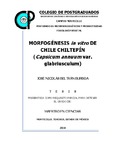| dc.contributor.author | Beltrán Burboa, José Nicolás | |
| dc.creator | BELTRÁN BURBOA, JOSÉ NICOLÁS | |
| dc.date.accessioned | 2018-10-29T17:53:20Z | |
| dc.date.available | 2018-10-29T17:53:20Z | |
| dc.date.issued | 2018-09 | |
| dc.identifier.uri | http://hdl.handle.net/10521/3056 | |
| dc.description | Tesis (Maestría en Ciencias, especialista en Fisiología Vegetal).- Colegio de Postgraduados, 2018. | es_MX |
| dc.description.abstract | El chile chiltepín es una especia que se colecta de plantas silvestres y enfrenta fuerte presión antropogénica por su extracción irracional. Asociado con problemas de baja germinación, demanda creciente y nulas prácticas de manejo agronómico la especie podría verse amenazada en el corto plazo. El presente estudio tuvo como objetivos establecer las condiciones óptimas para la germinación in vitro de chile chiltepín y desarrollar un método eficiente para la morfogénesis in vitro de plantas por organogénesis. Las semillas se desinfectaron con 20 % (v/v) de NaOCl por 15 min. Para promover la germinación se evaluaron tratamientos de acondicionamiento por tiempos de inmersión en H2O2 3 % y en AG3 a 2.89 y 5.78 µM, también éstas concentraciones fueron adicionadas al medio de cultivo. Para la organogénesis se evaluaron tipos de explantes y concentraciones de BAP así como combinaciones de BAP y AIA para la inducción y multiplicación de brotes. En el alargamiento de brotes se evaluaron concentraciones de AG3 y en el enraizamiento el AIB. La mejor respuesta de germinación in vitro (90 %) se obtuvo al sumergir las semillas por 30 min en 5.7 µM de AG3 y adicionándolo al medio MS con 50 % de concentración de sales. La organogénesis se indujo a partir de segmentos nodales con yemas axilares donde se obtuvieron 6.6 brotes por explante con 11.1 µM de BAP y 2.8 µM de AIA. La multiplicación de brotes se obtuvo en estas mismas combinaciones de reguladores de crecimiento. El alargamiento de los brotes se favoreció en medio MS con 11.5 µM de AG3 y el enraizamiento se indujo con 10.0 y 12.5 µM de AIB. _______________ In vitro MORPHOGENESIS OF CHILTEPIN PEPPER (Capsicum annuum var. glabriusculum). ABSTRACT: Chiltepin pepper is a spice that is collected from wild plants and faces strong anthropogenic pressure due to its irrational extraction. Associated with problems of low germination, growing demand and null management practices the species could be threatened in the short term. The present study had as objectives to establish the optimal conditions for the in vitro germination of chiltepin pepper and to develop an efficient method for the in vitro morphogenesis of plants by organogenesis. The seeds were disinfected with 20% (v/v) of NaOCl for 15 min. To promote germination conditioning treatments were evaluated for immersion times in H2O2 3% and in GA3 at 2.89 and 5.78 µM, also these concentrations were added to the culture medium. For organogenesis explants and BAP concentrations were evaluated as well as combinations of BAP and IAA for the shoots induction and multiplication. In the elongation of shoots GA3 concentrations were evaluated and in the rooting the IBA. The best in vitro germination response (90%) was obtained by immersing the seeds for 30 min in 5.7 μM of GA3 and adding it to the MS medium with 50% concentration of salts. Organogenesis was induced from nodal segments with axillary buds where 6.6 shoots were obtained per explant with 11.1 μM of BAP and 2.8 μM of IAA. The shoots multiplication was achieved in these same combinations of growth regulators. The elongation of the shoots was obtained in MS medium with 11.5 μM of GA3 and the rooting was induced with 10.0 and 12.5 μM of IBA. | es_MX |
| dc.description.sponsorship | Comisión Nacional de Ciencia y Tecnología (CONACyT). | es_MX |
| dc.format | pdf | es_MX |
| dc.language.iso | spa | es_MX |
| dc.rights.uri | http://creativecommons.org/licenses/by-nc-nd/4.0 | es_MX |
| dc.subject | Ácido giberélico | es_MX |
| dc.subject | Germinación | es_MX |
| dc.subject | Micropropagación | es_MX |
| dc.subject | Morfogénesis | es_MX |
| dc.subject | Silvestre | es_MX |
| dc.subject | Giberelic acid | es_MX |
| dc.subject | Germination | es_MX |
| dc.subject | Micropropagation | es_MX |
| dc.subject | Morphogenesis | es_MX |
| dc.subject | Wild | es_MX |
| dc.subject | Fisiología Vegetal | es_MX |
| dc.subject | Maestría | es_MX |
| dc.subject.classification | CIENCIAS AGROPECUARIAS Y BIOTECNOLOGÍA::CIENCIAS AGRARIAS::AGRONOMÍA::TÉCNICAS DE CULTIVO | es_MX |
| dc.title | Análisis del potencial antivirulencia de dos mezclas de fenoles de cadena larga en Chromobacterium violaceum. | es_MX |
| dc.type | Tesis | es_MX |
| Tesis.contributor.advisor | López Peralta, María Cristina Guadalupe | |
| Tesis.contributor.advisor | Hernández Meneses, Eleodoro | |
| Tesis.contributor.advisor | Cruz Huerta, Nicacio | |
| Tesis.date.submitted | 2018 | |
| Tesis.date.accesioned | 2018 | |
| Tesis.date.available | 2018 | |
| Tesis.format.mimetype | pdf | es_MX |
| Tesis.format.extent | 2,011 KB | es_MX |
| Tesis.subject.nal | Cultivo in vitro | es_MX |
| Tesis.subject.nal | In vitro culture | es_MX |
| Tesis.subject.nal | Plantas silvestres | es_MX |
| Tesis.subject.nal | Wild plants | es_MX |
| Tesis.subject.nal | Organogénesis | es_MX |
| Tesis.subject.nal | Organogenesis | es_MX |
| Tesis.subject.nal | Embriogénesis somática | es_MX |
| Tesis.subject.nal | Somatic embryogenesis | es_MX |
| Tesis.subject.nal | Sustancias de crecimiento vegetal | es_MX |
| Tesis.subject.nal | Plant growth substances | es_MX |
| Tesis.rights | Acceso abierto | es_MX |
| Articulos.subject.classification | Capsicum annuum | es_MX |
| dc.type.conacyt | masterThesis | es_MX |
| dc.identificator | 6||31||3103||310305 | es_MX |
| dc.contributor.director | LOPEZ PERALTA, MARIA CRISTINA GUADALUPE; 3082 | |
| dc.audience | generalPublic | es_MX |


